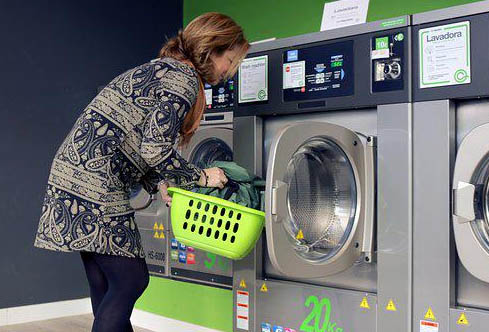Front-loading washers are prone to odorous mold and mildew buildups, which can make the laundry and the house smell bad. With front-load washers, mold growth is particularly prone to occur around the rubber door seal. Water frequently gets trapped in the rubber gasket around the door, which over time encourages the growth of mold. Only by routinely cleaning the front-load washer’s rubber seal in accordance with the steps below will mold growth be removed.
How To Clean Washing Machine Rubber Seal
- White Vinegar
White vinegar can be used to clean the rubber seal if it only requires a quick touch-up clean or if a service wash did not completely remove the dirt. We choose a mixture of cotton wool balls and buds for this trick, which calls for white vinegar.
White vinegar can be used to dampen cotton wool balls (or pads) to remove mold from the rubber seal’s large surface areas by wiping or scrubbing the mold.
White vinegar should only be allowed to sit for a few minutes before being wiped over any particularly difficult mold.
Use a cotton bud to clean the difficult-to-reach areas of the seal. To remove the mold and debris that has become lodged there, pull the seal’s fold forward with your fingers and use a cotton bud dipped in vinegar to do so.
Be ready before you begin; you’ll probably need quite a few cotton swabs to clean the entire seal.
The interior of the seal should be thoroughly cleaned because mold and debris can gather anywhere. It’s possible that the buildup is worse at the bottom of the seal, but this does not mean that the top of the seal is dirty and needs to be ignored. You must thoroughly clean the seal and then rinse off any remaining vinegar and dirt. The most straightforward method to do this is to run a hot, empty cycle on the washing machine.
- Dishwashing Detergent
Dishwashing liquid might be the ideal fix for you if the rubber seal on your washing machine is just a little bit contaminated. The rubber is not attacked by it because it is milder than many of the other varieties. So dishwashing liquid is a good choice for regular cleaning of the rubber on washing machines.
- Toothpaste
The most unexpected home remedy on our list is probably toothpaste. Without weighing it down, toothpaste aids in buffing the rubber back to its original shine.
- Citric Acid
Citric acid is among the best treatments for mold on the washer seal. Citric acid is not as powerful as other alternatives and conventional cleaners, so it has less of an impact on the rubber of washing machines. Your washing machine also gets a fresh scent from it.
How To Remove Black Mold From Washing Machine
You must use a cleaner in order to effectively remove the mold. Either homemade or store-bought cleaners are options. Homemade cleaners are simple to make, and we provide some instructions on how to make your own cleaner for removing mold.
Creating your own cleaner
You can mix hydrogen peroxide with water and lemon juice to create an effective homemade mold cleaner. Lemon and hydrogen peroxide are both effective mold-fighting agents. If you don’t have any hydrogen peroxide on hand, you can use white vinegar as a substitute. When battling mold, vinegar is a fantastic substitute for hydrogen peroxide. If you use bleach that has been diluted with water to remove mold, that will work as well.
Using the cleaner
You can begin using a commercial mold cleaner or your own homemade version of the mold once it has been prepared. To protect yourself from the mold and dirt inside the washing machine, be sure to put on rubber gloves and a face mask. The cleaner should then be placed in a spray bottle so that you can apply it to the rubber seal effectively.
You can begin rubbing it once you’ve sprayed the cleaner over the moldy area. To remove the mold from the seal, rub it with a cloth or towel. Apply the cleaner solution and let it sit for a short while in areas where there is a lot of molds. After that, rub the difficult-to-remove molds vigorously with an old toothbrush.
After using the cleaner
The washing machine’s drum and hose need to be cleaned because there might still be some mold residue there after you have completely cleaned the mold from the rubber seal. To get rid of any minor amount of mold that may be on your machine, run a cycle on it using the hottest setting of water and the mold cleaner. Your washing machine will be mold-free after the cycle is finished.
Repeat the cleaning cycle with the mold cleaner or other more potent additives if the smell still exists. In the event that the mold smell still exists after a second cleaning, you can finally hire a professional to remove the mold. It can be really challenging to clean mold that is sometimes present at the drum’s back. Therefore, to get rid of the mold-related odor, call a professional.
Cleaning the Dispenser
Don’t forget to clean the dispenser while cleaning the mold out of your washing machine. Remove the dispenser, then thoroughly wipe it down with a cloth or towel. When cleaning the dispenser, you can also use the mold cleaner for thorough cleaning. As much as possible without harming your washing machine, clean the dispenser.

Why Should I Clean The Seal?
Given the enormous amount of water that washing machines use, it is not surprising that mold grows on every surface inside a washing machine.
Without routine cleaning, this can accumulate and turn into a major issue. The rubber seal is frequently ignored as part of routine cleaning, but if this area is not attended to, it can become unhygienic and cause some unpleasant odors.
Even if you routinely perform service cycles and clean the inside of the drum, you still need to be sure to reach the difficult-to-reach areas on the inside of the seal.
How Frequently Should The Rubber Seal Be Cleaned?
Whenever you perform a service wash! Most washing machine manufacturers advise running a service wash on your machine once a month, particularly if it gets a lot of use or is used for dirty clothes.
Attempt to routinely inspect the seal for any visible mold growth in addition to this routine cleaning. When unloading the machine and you see dirt on the seal’s surface, that is a clear sign that you need to clean the seal right away to prevent the growth of mold.
If you’ve ever washed a tissue by mistake, you may have discovered it clumped inside the rubber seal folds; always check this area after washing to make sure no undissolved washing tabs are lodged there. These may be the root of some of the unpleasant washing machine odors.
How To Prevent Mold Buildup
When it comes to washing machine mold, prevention is always better than cure.
Thankfully, there are a few easy steps you can take to stop mold and mildew from growing on the interior of the seal.
- When the machine isn’t in use, leave the door open. Keep the door open after a cycle is finished so that air can circulate and the surfaces can dry on their own.
- As soon as the cycle is complete, remove the laundry. If the water in the machine is allowed to build up and become stagnant, it provides the ideal environment for bacteria to flourish. Just take the washing out as soon as you can to avoid this!
- The surfaces around the door, rubber seal, and glass should be dried after a cycle to remove any debris or detergent that may have accumulated there.
The temperature of the wash is one factor in the mold buildup that occurs in many washing machines.
Most washing machine cycles are frequently run at 40 degrees or lower, which may be more environmentally friendly but does not effectively clean the machine’s interior.
Regularly washing at lower than 40 degrees can leave some detergent residue behind, which promotes the growth of mold and dirt.
Conclusion
In order to improve hygiene, it is necessary to keep all household appliances, including the washing machine, clean. It is essential to keep the washing machine free of black mold because it maintains and cleans our material. The development of black mold in the rubber door seal frequently affects the cleaning process quality. With this article, we hope to help you prevent and remove black mold growth in your washing machine.
If you have other problems with washing machines, welcome to check the following guides!
- How to Use Bleach In Your Washing Machine – Is It Safe to Use
- Can You Transport A Washing Machine On Its Side When Moving?
- How to Reset Electrolux Washing Machine With Easy Methods
- Can You Add An Agitator To A Washing Machine – How to Use
- How To Break Into Car Wash Change Machines In Simple Ways?
- How Can I Find Lost Items in the Washing Machine
- How To Install & Vent A Washing Machine Drain Pipe
- How to Reset Your Whirlpool Washing Machine? So Easy!
- How to Level a Washing Machine – Find The Perfect Level
- How to Clean a Smelly Washing Machine – Hacks & Tips
- How Much Does Different Washing Machine Weigh?
- How Long Does a Washing Machine Take to Wash & Dry Clothes?
- Do Converse Shoes Well in a Washing Machine?
- How To Wash A Hat In The Washing Machine? Something You Should Know
- How to Clean Mold from a Washing Machine With Tips
- How to Level a Washing Machine? Step by Step Guide
- Can You Put Crocs In The Washing Machine? You Need Know
- How To Vent A Washing Machine Drain Pipe With Easy Steps











